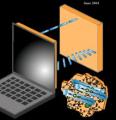Extensive research efforts to study the novel electronic properties of high-Tc superconductors and their related materials by angle-resolved photoemission spectroscopy at a recently commissioned Beam Line 5-4 (led by Z.-X. Shen) continue to be successful, producing many important results. These results, which are highlighted by five articles recently published in Physical Review Letters and one in Science, brought our understanding steps closer to solving the mystery of the high-Tc superconductivity.
Approximately 1,700 scientists visit SSRL annually to conduct experiments in broad disciplines including life sciences, materials, environmental science, and accelerator physics. Science highlights featured here and in our monthly newsletter, Headlines, increase the visibility of user science as well as the important contribution of SSRL in facilitating basic and applied scientific research. Many of these scientific highlights have been included in reports to funding agencies and have been picked up by other media. Users are strongly encouraged to contact us when exciting results are about to be published. We can work with users and the SLAC Office of Communication to develop the story and to communicate user research findings to a much broader audience. Visit SSRL Publications for a list of the hundreds of SSRL-related scientific papers published annually. Contact us to add your most recent publications to this collection.
Today's laptop computers utilize flat panel displays where the light transmission from the back to the front of the display is modulated by orientation changes in liquid crystal (LC) molecules. Details are discussed in Ref. 2 below. One of the key steps in the manufacture of the displays is the alignment of the LC molecules in the display. Today this is done by mechanical rubbing of two polymer surfaces and then sandwiching the LC between two such surfaces with orthogonal rubbing directions. Over the past years a great challenge of this $20 billion/year industry has been to devise an alternative method of liquid crystal alignment. The rubbing process is plagued with contamination issues and the polymer film is deposited by a wet process that is incompatible with high-tech manufacturing techniques.
The combined use of x-ray crystallography and solution small angle x-ray scattering has enabled a research collaboration involving scientists from Boston College and SSRL to provide structural evidence supporting a 30-year old model accounting for the cooperative binding of ligands to allosteric proteins and enzymes - a function central to physiology and cellular processes.
RNA Polymerase transcribes genetic information into a message that can be read by the ribosome to produce protein The research group of Professor Roger Kornberg of Stanford University has studied the structure of this 12-subunit and half-megadalton size macromolecular machine using diffraction data collected at SSRL.








